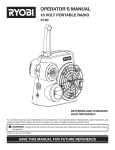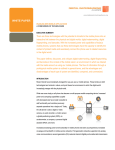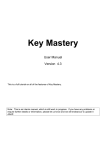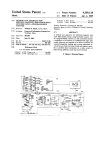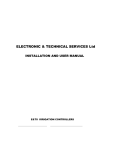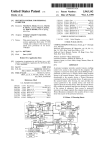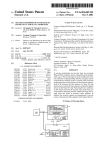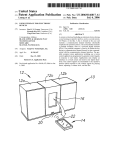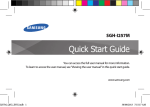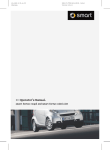Download llllllllllllllllllllllIllllllllllllllIlllllllllllllllllllllllllIllIIIIHIII
Transcript
llllllllllllllllllllllIllllllllllllllIlllllllllllllllllllllllllIllIIIIHIII
USOO5375243A
United States Patent [191
Parzych et a1.
[11]
Patent Number:
5,375,243
'[45]
Date of Patent:
Dec. 20, 1994
[54] HARD DISK PASSWORD SECURITY
SYSTEM
5,012,514
4/1991
Renton .................................. .. 380/4
5,097,506 3/ 1992
5,173,940 12/1992
Kaiser, Jr. et a1. .
..... .. 380/25
Lantz et a1. ......................... .. 380/25
[75] Inventors: James D. Parzych; Richard
Tomaszewski, both of Houston;
OTHER PUBLICATIONS
Norman P. Brown; Roger P.
Anderson, both of Tomball; David M.
Douglas, Houston; Kenneth W.
Stuf?ebeam, Spring, all of Tex.
Disklock Advertisement, PC Magazine, vol. 10, No. 11,
Jun. 11, 1991; New York, New York; p. 139.
Fastlock User’s Manual, Version 1.0, Rupp Corp, New
York, New York.
Primary Examiner—Eddie P. Chan
Attorney, Agent, or Firm-Pravel, Hewitt, Kimball &
[73] Assignee: Compaq Computer Corporation,
Houston, Tex.
Krieger
[21] Appl. No.: 208,052
[22]
Filed:
[57]
Mar. 7, 1994 .
Related US. Application Data
[63]
password. When the computer system is powered up,
the hard drive spins up and is tested, responding only to
Continuation of Ser. No. 772,695, Oct. 7, 1991, aban
cloned.
[51]
[52]
a limited set of commands that do not permit data stor
age or retrieval operations. The password is located on
Int. Cl.5 ....................... .. G06F 12/00; H04L 9/32
US. Cl. ...................................... .. 395/725; 320/4;
the hard disk itself to prevent bypassing the hard drive’s
security using a new computer environment. When the
380/52; 380/25; 380/50; 395/575; 395/425;
364/2225; 364/2864; 364/2865; 364/9692;
Field of Search ..................... .. 395/425, 575, 725;
user enters the correct password, the hard drive unlocks
and operates as a conventional hard drive. If the user
chooses, the hard drive may be unlocked by either of
380/4, 23, 25, 50, 52; 340/ 825.31, 825.34
two passwords, one de?ned by the user and the other by
364/9694; 364/9187; 364/DIG. 1
[58]
ABsTRAcr
A hard drive which prevents data access operations on
the hard drive upon power up until the user enters a
[56]
References Cited
the manufacturer. To obtain access to data areas during
a locked state, a wipe data command is provided which
overwrites all user data on the drive and unlocks the
US. PATENT DOCUMENTS
3,890,601
6/1975 MPietrolewicz ............... .. 364/DIG. 1
duve
4,959,860
4,942,606 _9/
7/ 1990 Kaiser
Watterseteta1.a1. .......................
. . .. 380/4
18 Claims, 6 Drawing Sheets
1O
t
f...
16 j
MICROPROCESSOR
14
MAIN
’‘
RAM
L12
9
BUS
CONTROLLER
c -/
_|——]
ADDRESS
BUFFER
25 J
r3“
DATA
BUFFER
L 28
' 20 7
' 22 7
L24
f
32
f
VIDEO
KEYBD
DISPLAY
KEYED
CTRLR
36
l/F
40
f 46
PORT
FLOPPY
I/F
Sggg}
CTRLR
F’Agélé'e?
EEPROM
FLOPPY
ROM
RTC
CMO/S
I
HARD DISK
UNIT
MICROPROCESS
OTHER DRIVE
L 34
\_ 38
\_ 44
\_ 42
\_ 48
ELECTRONICS
k 60
US. Patent
Dec. 20, 1994 ‘
Sheet 2 0f 6
5,375,243
300
PRIOR POWER
ON OPERATIONS
CLEAR SWAPPEDI
SET SWAPPED
308
PASSWORD
ENABLED
312-}
r310
SET LOCKED
CLEAR LOCKED |
314
FIG. 2
US. Patent
Dec. 20, 1994
Sheet 3 of 6
400
DRIVE COMMAND
INTERPRET
402
PASSWORD
COMMAND
SWAPPED
SET
I?
ALLOWED
COMMAND
8-416
Y
RETURN
ERROR
406 q
PERFORM COMMAND
408
FIG. 3A
5,375,243
US. Patent
Dec. 20, 1994
5,375,243
Sheet 4 of 6
420
SWAPP ED
423
425 —7
LOCKED
‘?
N
DISABLE
PASSWORD
CHANGE
427
‘ RETURN )
429
PASSWORD
CHANGE
DISABLED
Y
N
PRECIOMP
AA
?
Y
428 —7
436-7‘
STORE
UNLOCK
DRIVE
PASSWORD
VALUES
43o
458
‘
‘
( RETURN )
( RETURN )
S. 422
RETURN
ERROR
FIG. 3B
US. Patent
Dec. 20, 1994
5,375,243
Sheet 5 of 6
124
112-1;
SUPPORT
HARD DISK
POWER ON
PASSWORD
ENABLED
PASSWORD
'2
EXIT
7
Y
{- 114
PROMPT FOR
SECURITY LEVEL
SELECTED
Y
[-130
(-118
{-120
122
I‘
PROMPT FOR
ON PASSWORD
PASSWORD
I
STORE ZEROS
IN BUFFER
PASSWORD
COMMAND
I
HDPW = POWER
‘
{-132
STORE PW IN
FIRSTHALF
I
k... EXIT
{- ‘I38
Y
STORE DRIVE
NUMBER IN
SECOND HALF
{-135
STORE PW IN
SECOND HALF
STORE FIRST HALF
AT FIRST LOCATION
142
ENCRYPT '
SECOND HALF
I
STORE SECOND HALF
AT SECOND LOCATION
FIG. 4
I
144
J
146
DISABLE SET OR h/
CHANGE PASSWORD
148
i
k“ EXIT
US. Patent
Dec. 20, 1994
5,375,243
Sheet 6 of 6
I START
I
I
I210
ID COMMAND
212
SUPPORT
HDOPW
214-]
EXIT
218
C LEAR ATTEM PT
COUNTER
C- 220
PROMPT FOR
PASSWORD
222
I
DOWNLOAD
ENTRY TO BUFFER
I
PASSWORD
COMMAND
I
f 226
ID COMMAND
236') ‘
INCREMENT
COUNTER
OK DISPLAY
232
L
STORE 55h
J
IN PRECOMP REG.
I
PASSWORD
COMMAND
MARK DISK
UNBOOTABLE
EXIT
FIG. 5
1
5,375,243
2
but the data will be meaningless if it is not decoded.
HARD DISK PASSWORD SECURITY SYSTEM
This is a continuation of co-pending application Ser.
No. 07/772,695 ?led on Oct. 7, 1991 now abandoned.
BACKGROUND OF THE INVENTION
1. Field of the Invention
The invention generally relates to hard drives used
with computer systems and more particularly to a
method and apparatus for preventing access to the hard
drive until a password is entered.
2. Description of the Related Art
Encryption, however, requires support hardware and
software in the computer system to encode and decode
the data. Encryption also reduces the computer sys
tem’s performance due to the delay while the encryp
tion mechanism encodes or decodes the data.
SUMMARY OF THE PRESENT INVENTION
The present invention prevents unauthorized access
to the hard drive unit by placing an access password on
the hard drive itself. When the computer system is pow
ered up, the hard drive unit is in a LOCKED state and
demands the password before access is allowed. No
The rising popularity of portable computers has cor
access to the hard drive, other than to wipe all of the
responded to the extraordinary improvements in the 15 data from the drive or to check the drive’s status, is
?eld, as portable computer systems rapidly develop the
capabilities and characteristics of desktop models. For
example, LCD displays for portable computers have
become more sophisticated and readable. Many porta
bles now include floppy disk drives to allow improved
versatility and capacity. Furthermore, hard disk units
are becoming common, offering greater speed and ca
pacity than ?oppy drives.
The integration of hard drives into portable comput
ers provides the user with much greater memory than 25
floppy disk drives. Hard drives offer considerably
shorter access times to data and programs. Conse
quently, the information that is most important to the
user is commonly stored on the hard drive where the
user has ready access. Information on the hard disk,
therefore, may be extremely con?dential and valuable,
and must be protected. Ordinarily, access to the system
as a whole is protected by a password program that
permitted until the password on the hard disk is entered
by the user. If the user attempts to gain access to the
drive by removing the drive from the original computer
and placing it in another system, the hard drive remains
inaccessible. Because the password is located on the
hard drive instead of in the system CMOS, the disk will
remain LOCKED regardless of the computer system in
which it is operating.
In the preferred embodiment, the hard drive contains
two passwords. The ?rst: is a user de?ned password
that is established by the usual operation of the com
puter. The second is a password determined by the
manufacturer, stored on the drive after encryption ac
cording to an algorithm known only to the manufac
turer. Only one of the passwords is required to unlock
the system. If the ?rst password is forgotten, the user
can contact the manufacturer or authorized facility.
After verifying true ownership, the manufacturer or
Password programs commonly employ a power-on 35 authorized facility uses the serial number of the hard
drive to determine the unit’s second password and
password stored in the computer’s CMOS memory.
allow the user access. After regaining access, the user
When the computer system initially powers up and
may then change the ?rst password to something the
completes the self-test operations, the computer exe
user is more likely to remember.
cutes a power-on password program. The password is
Alternatively, the user may choose to restrict access
read from the CMOS and compared to the password
to the hard drive with only a single password. The
entered by the user on the keyboard to determine
password is created by the user and provides the sole
whether the correct password has been given. If so, the
restricts access to those that enter a password.
means of access to the hard drive. The manufacturer’s
password is omitted from the drive so that even the
tered. Many systems allow only a few attempts at enter 45 manufacturer cannot gain access to the drive unit. If the
user is allowed access to the system. If not, the system
remains inaccessible until the correct password is en
ing a password, after which the system must be turned
off and powered up again to make another attempt.
password is forgotten, however, the user’s only option
is to wipe all of the data from the unit, thereby losing all
of the information stored on the disk. The hard drive is
For conventional desktop models, password pro
grams generally provide sufficient defense to unautho
then reset to its UNLOCKED status, and the user can
rized access. For portable computers, however, power
on password protection may not be enough. Unlike
their desktop counterparts, portable computers are eas
provide a new password for the drive.
Capabilities to activate and deactivate the hard drive
password feature are also provided.
ily stolen. A portable computer may be equipped with
power-on password protection, which will prevent
unauthorized access to the information on the hard disk 55
unit through the computer system, but the hard drive
unit may be physically removed from the computer and
installed in another system. Because the new system
does not employ password protection, the hard drive
BRIEF DESCRIPTION OF THE DRAWINGS
A better understanding of the present invention can
be obtained when the following detailed description of
the preferred embodiment is considered in conjunction
with the following drawings, in which:
FIG. 1 is a block diagram of a computer incorporat
becomes accessible to an unauthorized user, and the
ing the present invention;
data vulnerable to theft and misuse.
To prevent unauthorized access of this sort, the data
may be encrypted before it is placed on the hard disk.
FIG. 2 is a flowchart illustration of a portion of the
power on sequence of a hard drive according to the
Encryption involves altering the standard data code
present invention;
FIGS. 3A and 3B are flowcharts illustration of a
into a secret code, which must be decoded when it is 65 portion of the command sequence of a hard drive ac
retrieved from memory before the data can be used. An
cording to the present invention;
unauthorized user may thus put the drive in another
FIG. 4 is a ?owchart illustration of operating sequen
computer to gain access to the code on the hard disk,
ces of the main processor for setting up the hard disk
3
5,375,243
password feature according to the present invention;
4
mands of an IDE drive are known to those skilled in the
and
FIG. 5 is a ?owchart illustration of the operating
sequence of the main processor for the hard disk pass
art. Alternatively, other hard drives which contain
microprocessors, such as SCSI and ESDI drives, may
also operate according to the present invention.
word security system according to the present inven 5
Proceeding now to the operation of the hard drive
tion.
security system, the hard disk password option allows
the user to choose one of three levels of security. The
DETAILED DESCRIPTION OF THE
user may choose no security at all, in which case the
PREFERRED EMBODIMENT
hard disk password is disabled and all hard disk com
Referring now to FIG. 1, the letter C generally repre
mands are functional. If protection is desired, the user
sents a computer incorporating the present invention. A
has a choice of two levels of security. LEVEL 1 pro
number of different blocks are used in the computer C.
vides the highest degree of protection to the user, as
This description of the computer C is provided to be
only one password, up to seven characters de?ned by
exemplary of the environment of the invention and is
the user, is stored on the hard drive. All hard drive
not intended to be limiting as to the particular arrange 15 commands become functional only after the user de
ment of the illustrated computer C.
?ned password is entered following the power-on self
The foundation of a computer system C according to
test (POST) procedure. This is the UNLOCKED state.
the present invention is a microprocessor 10. The mi
Until the password is entered, the drive remains
croprocessor 10 has a host address bus 12, a host data
LOCKED, a non-volatile programmable state in which
bus 14, and a host control bus 16. A main memory 18,
the drive honors only a limited set of commands, as
composed of random access memory (RAM), is con
speci?ed below. All other commands are aborted. No
nected to each of the host buses 12, 14, 16. The com
data may be retrieved from the bus interface or any
puter system C also includes a system control bus 20, a
service port. Consequently, only those that know the
system address bus 22, and a system data bus 24. The
user de?ned password have access to the hard drive. If
exchange of signals between the system buses 20, 22, 24 25 the user forgets the password, however, there is no way
and host buses 12, 14, 16 is controlled by a bus control
for the user to retrieve data. The only way to regain
ler 26. An address buffer 28 is connected to the host
access to the drive is by executing the WIPE DATA
address bus 12 and the system address bus 22, and a data
command, which writes over all data on the hard drive,
buffer 30 is connected to the host data bus 14 and the
as described in more detail below.
system data bus 24. Each buffer 28, 30 is controlled by 30 For LEVEL 2 security, two passwords unlock the
signals from the bus controller 26.
hard drive. The ?rst is the user de?ned password as
The system buses 20, 22, 24 are connected to a series
described above. The second password is preferably
of peripheral devices. A video controller 32 is coupled
derived from the hard drive’s serial number and is en
to each of the buses 20, 22, 24, and to communicate
crypted according to a particular algorithm and stored
information to the user, a display 34 is connected to the 35 at a second location on the hard drive. Either password
unlocks the hard drive. If the user forgets the user de
?ned password, the user can take the drive to the manu
facturer or a dealer. After verifying ownership, the
the user to enter desired character sequences and com
dealer contacts the manufacturer and conveys the hard
mands. Coupled to each of the system buses 20, 22, 24 is
drive’s serial number. The manufacturer encrypts a
a port interface 40, which provides a parallel port 42
portion of the serial number, such as the last seven non
video controller 32. In addition, a keyboard interface 36
is connected to the system buses 20, 22, 24. Connected
to the keyboard interface 36 is a keyboard 38 to allow
and a serial port 44. A ?oppy disk controller 46 is fur
ther connected to each system bus 20, 22, 24. A ?oppy
disk unit 48, used to provide storage for the computer
C, is connected to the ?oppy disk controller 46. An 45
electrically erasable programmable read only memory
(EEPROM) 50, connected to each bus 20, 22, 24, retains
the extended setup information relating to board con?g
uration, as needed in a system according to the Ex
tended Industry Standard Architecture (EISA) or as
needed for other purposes. A read only memory (ROM)
52 includes the necessary basic operating software uti
blank characters, using the same algorithm as that in
cluded in the computer. When the encryption is com
plete, the manufacturer gives the resulting password to
the dealer, who then uses the password to unlock the
hard drive. After the hard drive has been UN
LOCKED, the user de?ned password can be changed
to suit the user.
Thus, the user can enable the hard disk password
option by choosing LEVEL 1 or LEVEL 2 security.
Either option places the disk unit in a LOCKED state
when the hard drive is next power cycled. When power
lized in a computer system C and is connected to each
is applied to the system, the system commences its
of the system buses 20, 22, 24. In addition, a real time
POST or power on, self-test procedure. While POST is
clock (RTC)/CMOS memory 54 is connected to the 55 running, the POST program tests the hard drive to
system buses 20, 22, 24 to provide constant time of day
insure that it is operating, and checks the CMOS mem
functions and allow storage of various system constants
ory to be certain that it contains the correct hard disk
and values related to the system con?guration and op
information. The hard drive unit spins up and becomes
tions. Finally, a hard disk unit 60 is connected to each
ready to operate, but remains in its LOCKED state.
bus 20, 22, 24. The hard disk unit 60 includes a hard 60 When all sub-system tests have been completed, the
drive and a controller for regulating access to and from
POST program executes the power-on password code,
the hard disk. For the storage of particular operating
if it is enabled, followed by the hard disk password
data, the hard disk controller includes a precompensa
code. The screen is cleared and the user is prompted for
tion register. Preferably the hard drive is an IDE or
the hard disk password. Until the password is entered,
integrated drive electronics unit wherein the drive con 65 the drive remains LOCKED, and only a limited set of
troller includes a microprocessor and is affixed to the
commands is honored by the drive. All other com
drive and receives commands via a port connected to
mands are aborted, allowing no data retrieval from the
the buses 20, 22, 24. Operation and conventional com-,
user sectors, interfaces, or service ports. The set of
5
5,375,243
commands honored by the drive while in the LOCKED
6
In spite of the password security system on the drive,
state includes, however, those that are required to com
an unauthorized person might be able to bypass the
plete the POST operations. These commands allow the
password feature by exchanging the ?rmware associ
computer system to determine whether the disk drive is
ated with the microprocessor located on the drive. The
simplest way to change the ?rmware would be to re
place the printed circuit board on the drive with a cir
operating properly. The commands do not, however,
allow any data retrieval from the disk. These commands
are the ID, initiate drive parameters, seek, recalibrate,
cuit board that does not the employ password security
code. A circuit board from another disk drive could
also be used to access the data without using the pass
word routine. To prevent this sort of access, the pass
word protected drives incorporate a unique sector for
mat so that circuit boards from prior model hard drives
write to the buffer and read verify commands.
While LOCKED, the disk drive particularly re
sponds to three commands. The ?rst is the ID com
mand, which causes the hard drive to provide informa
tion and a series of parameters identifying the hard
drive’s characteristics and status. When the ID com
mand is issued, the response indicates the serial number
are not compatible. As a result, the unauthorized user
would be denied access.
of the drive, whether the password option is supported
To enhance security, the two passwords may also be
on that drive, and whether the drive is LOCKED or
UNLOCKED. The ID command must be honored
while the drive is LOCKED to allow the system to
stored at two more locations elsewhere on the disk. In
addition, the hard drive includes; another method for
detecting a circuit board swap. When the user enters the
user de?ned password, the password is stored on the
20
magnetic
media and in an EEPROM located on the
executed.
drive as well. The next time the system is powered up,
The WIPE DATA command, a new command, is
the password stored at the ?rst location on the hard disk
honored only when the drive is in a LOCKED state,
determine whether the password routine should be
and aborts if the drive is UNLOCKED. When the
WIPE DATA command is issued, the drive is set busy
until all user data sectors have been written over. Upon
completion, the drive resets to an UNLOCKED, pass
word-disabled state and clears the busy signal. If the
drive is interrupted during the WIPE DATA com
mand, it remains in a LOCKED state. The WIPE
DATA command allows the user to regain usage of the
disk drive if the password is forgotten, although all data
on the disk drive is lost.
The disk drive also honors the PASSWORD com
mand, another new command, which performs different
functions, depending on the contents of a precompensa
tion register and whether the disk drive is LOCKED or
UNLOCKED. One of two preferred values, such as
AAh or 5512, must be in the precompensation register
for the PASSWORD command to work. Otherwise, an
25
is compared to the password stored in the EEPROM. If
the passwords match, the circuit board has not been
replaced, and the system power up sequence proceeds.
If the passwords do not match, however, the circuit
board has been swapped. The password code then exits,
and the drive remains LOCKED. The drive cannot be
unlocked until the original circuit board is returned to
the drive.
Operation of the drive as discussed above is shown in
FIGS. 2, 3A and 3B. In step 300 the drive will have
proven performing prior power-on operations. Control
then proceeds to step 302 to determine if the password
values contained in the EEPROM and on the magnetic
media are equal. If not, this is an indication that the
circuit board has been swapped and control proceeds to
step 304 to set a swapped flag. If not, control proceeds
to step 306 where the swapped flag is cleared. From
steps 304 and 306 control proceeds to step 308 to deter
aborted command message will be returned. If an AAh
mine if the password feature is enabled. If not, control
value is in the precompensation register and the drive is
proceeds to step 310 where the LOCKED bit is cleared.
UNLOCKED when the PASSWORD command is
If it is enabled, control proceeds from step 308 to step
asserted, the disk drive will receive the contents of the
312 where the LOCKED bit is set. Control proceeds
sector buffer, encrypt the contents of the second half of 45 from step 310 or step 312 to the remaining operations in
the buffer, and store the contents of both halves at two
power-on.
password locations on the hard drive. Thus new pass
Once the hard drive is in operation and power-on
word values are written to the hard drive. If an AAh
procedures have been completed, one of the functions
value is in the precompensation register and the drive is
of the drive is to scan for drive commands. When a
LOCKED, however, the drive unit will receive the
command is received it proceeds to an interpreter se
contents of each half of the sector buffer and compare
quence 400 shown in FIG. 3. The ?rst step of sequence
them to the passwords stored at the two locations on the
402 determines if the password command has been re
hard disk, respectively. If the sector buffer contents
ceived. If not, control proceeds to step 404 to determine
match either of the passwords, the drive unit will be
if the ID command had been received. If so, control
unlocked.
55 proceeds to step 406 and the ID command is performed.
When the PASSWORD command is issued with a
Control then proceeds to step 408 where the ID value is
55h value in the precompensation register and the drive
returned. If it is not an ID command, control proceeds
is UNLOCKED, the set or change password capacity
from step 404 to step 410 to determine if the swapped
of the disk drive is disabled. When the set or change
flag is set. If not, control proceeds to step 412 to deter
password capacity is disabled, the passwords stored at 60 mine if the drive is LOCKED. If not, control proceeds
the two locations on the hard disk cannot be changed or
to step 406 and the desired command is performed. If
removed. The set or change password capacity will
the drive is LOCKED as determined in step 412 or the
remain disabled until the drive is power cycled. If the
board has been swapped as determined in step 410,
drive is LOCKED when the PASSWORD command is
control proceeds to step 414 to determine if the com
issued with a 55h value in the precompensation register, 65 mand is one of those allowed as indicated previously. If
an aborted command will be returned. Therefore, the
so, control proceeds to step 406 and the command is
set or change password capacity can only be disabled
performed. If not, control proceeds to step 416 where
when the disk drive is UNLOCKED.
an error value is set and control is returned.
7
5,375,243
If it was determined in step 402 that a password com
8
word. If the power-on password feature is enabled,
control proceeds to step 128, where the user is
mand had been received, control proceeds to step 420 to
determine if the swapped ?ag has been set. If so, control
prompted to choose whether to set the hard disk pass
proceeds to step 422 where an error flag is set and con
trol is returned. If not, control proceeds to step 421 to
word equal to the power-on password. Setting the hard
disk password equal to the power-on password allows
determine if a 55h value is in the precompensation regis
ter. If so, control proceeds to step 423 to determine if
the drive is LOCKED. If so, control proceeds to step
422. If not, control proceeds to step 425 where pass
the user to enter only one password to gain access to the
word changing is disabled. Control then returns in step
427.
words equal, control proceeds to step 130, where the
hard disk password is set equal to the power-on pass
If a value of 55h was not present in step 421, control
proceeds to step 424 to determine if the drive is
LOCKED. If not, control proceeds to step 429 to deter
mine if password changing is disabled. If so, control
proceeds to step 422. If not, control proceeds to step
word. If the user chooses to use a different password,
system following a cold boot, as described below, in
stead of entering both a power-on password and a hard
disk password. If the user chooses to set the two pass
control proceeds to step 126, and the user provides a
personally chosen seven character password.
From steps 126 and 130, control proceeds to step 132,
where the password determined in steps 126 and 130 is ,
entered in the ?rst half of the sector buffer. Control then
precompensation register. If not, control proceeds to
proceeds to step 134 where a determination is made
step 422. If so, control proceeds to step 428 where the
whether LEVEL 1 or LEVEL 2 security was chosen.
password values located in the sector buffer are stored, 20 If LEVEL 1 was chosen, control proceeds to step 136
both to the magnetic media and to the EEPROM. Con
and the password de?ned by the user in step 126 or 130
trol then proceeds to step 430 which is a return.
is stored in the second half of the sector buffer as well.
If the drive was locked in step 424, control proceeds
If LEVEL 2 security was chosen, control proceeds to
to step 432 to determine if the AAh value is located in
step 138 where certain characters of the drive serial
426 to determine if an AAh value is located on the
the precompensation register. If not, control proceeds
to step 422. If so, control proceeds to step 434 to deter
25 number, such as the last seven non-blank or non-space
digits, are placed in the second half of the sector buffer. _
The drive serial number is stored in the drive’s memory,
trol proceeds to step 436 where the drive is unlocked
and is retrieved using the ID command. Control pro
and to step 438 where the command status is returned.
ceeds from step 136 and step 138 to step 140 and the
If the passwords are not equal as determined in step 434, 30 PASSWORD command is issued. The drive looks for
control proceeds to step 440 to determine if the manu
one sector of data containing two seven-byte password
facturer or second passwords are equal. If not, control
entries in the sector buffer. The ?rst password entry is
proceeds to step 422. If so, control proceeds to step 436.
stored directly at a ?rst location on the hard disk. The
Therefore the hard drive operates according to the
password is stored in a reserved location on the disk
35 that is not accessible to users. Control then proceeds to
conditions and parameters set forth above.
A setup program initially sets and enables the hard
step 142 and the second password entry is encrypted
disk password. The ?ow diagram shown in FIG. 4
using circuitry located on the hard drive. The encryp
mine if the user or ?rst passwords are equal. If so, con
depicts the enabling procedure for the hard disk pass
tion is performed according to a proprietary algorithm
word. Initially, the system determines at step 110
known only to the manufacturer. Control then proceeds
whether the drive supports the hard drive password 40 to step 144 and the encrypted second password entry is
security using the ID command as discussed below. If
stored at a second non-user location on the hard disk.
the drive does not support the hard drive password, the
After the second password is stored by the hard drive,
routine exits at step 112. If the unit supports the hard
a completion signal is provided and operation of the
drive password, the user is prompted at step 114 to enter
system program proceeds to step 146 where a 55h value
a desired level of security. After the user enters a 45 is stored in the precompensation register. In hard drives
according to the preferred embodiment the precompen
choice, control proceeds to step 116, to determine
whether the selected security level was NONE. If the
sation register is used as a scratch pad register, the regis
ter remaining for compatibility reasons and the drive
NONE option was selected, control proceeds to step
118. Because the hard disk password is currently dis
not needing externally provided precompensation val
abled, the drive unit is already UNLOCKED, the fea 50 ues. The PASSWORD command is then issued and the
ture not being enabled by the manufacturer. Thus, the
set or change password capacity is disabled, preventing
further alteration of the password. The routine then
sector buffer is cleared, and control proceeds to step 120
where the PASSWORD command is issued and zeros
are stored on the disk. When zeros are placed in the
exits at step 148 and returns to the main setup program.
If the hard disk password was to be set or changed
sector buffer and stored at the hard disk locations for 55 after the initial setting, the above program would be
the passwords, the hard disk password feature is dis
modi?ed to determine if the hard drive was not
abled. In the disabled state, the drive is UNLOCKED
swapped and was UNLOCKED before prompting for
and the set or change password capacity remains en
the security level. If not, the program would exit.
abled. The routine then exits at step 122, and the hard
The hard disk password code is executed each time
disk remains UNLOCKED.
the system is power cycled. After the system completes
If LEVEL 1 or LEVEL 2 security is chosen in step
the POST operations, the power-on password code is
114, control proceeds from step 116 to step 124, where
the system determines whether the power-on password
is enabled. The power-on password feature protects the
executed if it is enabled. The hard disk password code,
depicted by the ?ow diagram in FIG. 5, then begins.
First, the ID command is issued in step 210, and the
entire computer system from unauthorized access as 65 results are tested in step 212 to determine whether the
discussed above. If the power-on password feature is
disabled, control proceeds to step 126, where the user is
drive supports the hard disk password option. If it does
not support the option, the routine exits at step 214. If it
prompted to enter a seven character, user de?ned pass
does, the results are again tested in step 216 to determine
9
5,375,243
Whether the disk drive is currently LOCKED. If the
drive is not LOCKED, the routine exits. If the drive is
LOCKED, control proceeds to step 218, where an
attempt counter, described in greater detail below, is
cleared. Control then proceeds to step 220 which
10
Therefore, the routine will exit and the password will
not have to be entered a second time.
The hard disk password may preferably be changed
or disabled in the hard drive password routine. When
the user is prompted for the hard disk password, the
user can change the password by typing the old pass
prompts the user to enter a password. The user then
enters a password of up to seven characters. From step
word followed by an exemplary character, such as a
forward slash (/), the new password followed by a
forward slash (/), and the new password again. If the
220, control proceeds to step 222 and the password
entered by the user is downloaded to each half of the
two new passwords are not identical, the password will
not be changed and an error message is displayed. This
ensures that the password entered is the one intended by
the user. As described above, the user entry is stored in
the sector buffer and the PASSWORD command exe
cuted. If the correct password was provided, the drive
will be UNLOCKED when the ID command is given.
Before the set or change password capacity of the drive
sector buffer.
Because an AAh value is preferably stored in the
precompensation register at the time the system is pow
ered up, when the PASSWORD command is given at
step 224, the drive expects to receive one sector of data
containing two seven-byte password entries in the sec
tor buffer. The hard drive controller compares the
entry in the ?rst half of the sector buffer with the pass
word stored at the ?rst location on the hard drive. If the
password matches the entry, the hard drive controller
is disabled, however, the, new password is loaded into
the sector buffer and the PASSWORD command is
again asserted. Because the drive is now UNLOCKED,
but an AAh value is still in the precompensation regis
unlocks the disk. If the password is incorrect, however,
the entry in the second half of the sector buffer is com
ter, the contents of the sector buffer are stored on the
pared to the encrypted password stored at the second
disk as described above. The 55h value is then stored in
location on the hard drive. If a match is found, the hard
the
precompensation register and the PASSWORD
drive is UNLOCKED. If not, the drive remains
LOCKED. At step 226, the processor issues the ID 25 command is asserted a third time, disabling the set or
change password capacity of the drive.
command and determines whether the password un
To disable the hard disk password altogether, the
locked the drive at step 228. If the drive is unlocked, an
user types the old password followed by two slashes.
OK symbol is displayed in step 230, a system internal
The
sequence described above is executed, but with
drive status flag is set to the UNLOCKED state, and 30
zeros stored in the sector buffer. At the end of the se
the system proceeds with all of the hard drive com
quence, the PASSWORD command is not asserted
mands available. In step 232, a 55h value is stored in the
with a 55h value in the precompensation register, and
precompensation register and the PASSWORD com
the set or change password capacity of the drive thus
mand is issued at step 234, thus disabling the set or
remains enabled.
change password capacity.
35
In addition, the password can be changed or disabled
If the entry matches neither password, the drive re
using the power on password routine. As described
mains LOCKED. Control proceeds from step 228 to
above, when the user is prompted for the power on
step 236, where the attempt counter is incremented by
password, the user types the old password followed by
l. The attempt counter re?ects how many times the
a forward slash (/), the new password followed by a
user has tried to enter a valid password and failed. Con
forward slash (/), and the new password again. When
trol then proceeds to step 238 and it is determined
the password is changed or disabled, the computer
whether the counter value equals 3. If the counter has
system also attempts to unlock and change the hard
not yet reached a value of 3, control returns to step 220
drive password as described above using the power on
to prompt the user for a another attempt at the pass
password. If the two passwords are identical, the hard
word. If the counter value has reached 3, a bad pass 45 disk password is also changed or disabled to remain
word prompt is displayed and the hard disk is marked as
identical with the power on password. The new pass
non-bootable at step 240, the set or change password
word is placed in the sector buffer and stored on the
capacity remains enabled, and the routine exits. After
hard disk as described above. The hard drive is also
the disk is so marked, it remains inaccessible to the user
UNLOCKED, and the set or change password capacity
until the system is power cycled and the user enters the
of the hard drive is disabled, preventing further alter
correct password, or the WIPE DATA command is _ ations of the hard drive password until the system is
executed.
power cycled.
In an alternative embodiment, the hard drive may
To change levels of protection, the hard disk pass
also be unlocked using the power on password pro
word feature must ?rst be disabled by entering the pass
gram, which runs immediately before the hard disk 55 word followed by two slashes. As described above, this
password code. When the user enters the password for
unlocks the drive, stores zeros on the hard disk, and
access to the computer system, the password is ?rst
leaves the set or change password capacity enabled.
used as the power on password. Next, the password is
The user must then run the setup program again and
directed to the hard drive and an attempt is made to
choose the desired level of security.
unlock it using the power on password. If the passwords 60 Similarly, if the power on password and the hard disk
are not the same, the attempt to unlock the hard drive
password are identical, the user can only change them
fails and has no other effect. If the passwords are the
same, however, the hard drive is unlocked and the set
to different passwords by ?rst disabling both password
features. Then the user can run the setup program and
or change password capacity will be disabled. The pro
cessor then ?nishes the power on password routine.
The computer system then executes the hard drive
password routine. When the processor checks the status
of the hard drive, the hard drive will be UNLOCKED.
65
provide new passwords.
The foregoing disclosure and description of the in
vention are illustrative and explanatory thereof, and
various changes in the size, shape, materials, compo
nents, circuit elements, wiring connections and
11
5,375,243
construction may be made without departing from the
spirit of the invention.
What is claimed is:
1. A hard disk drive having LOCKED and UN
password value from a user;
means coupled to said microprocessor and said user
password value receiving means for providing an
UNLOCK command with said user password
LOCKED states for use in a computer system, the hard
disk drive comprising:
value;
means on the hard disk drive for storing user data and
a password value for operating of the hard disk
drive;
12
means coupled to said microprocessor for storing
program steps;
means coupled to said microprocessor for receiving a
contacts, as well as in the details of the operation and
10
means on the hard disk drive for receiving a plurality
of commands including at least one password value
from the computer system;
a hard disk drive coupled to said microprocessor and
said user password value receiving means, said
hard disk drive having LOCKED and UN
LOCKED states and including:
means on the hard disk drive for storing user data and
means on the hard disk drive for locking access to the
hard disk drive to all but selected ones of said re
a password value for operation of said hard disk
ceived plurality of commands while in a LOCKED
state, one of said selected commands being an UN
LOCK command and another of said selected com
mands being a WIPE DATA command;
means on the hard disk drive for receiving a plurality
drive;
of commands from said microprocessor;
means on the hard disk drive for locking access to
said hard disk drive to all but selected of said plu
means on the hard disk drive for comparing a pass 20
rality of commands while in a LOCKED state, one
word value received from the computer system
with a stored password value upon receipt of said
UNLOCK command and unlocking the hard disk
drive if the compared password values are equal;
of said selected commands being said UNLOCK
command and another of said selected commands
being a WIPE DATA command;
means for coupling to a microprocessor and for pro
viding a WIPE DATA command to the hard disk
drive from the microprocessor: and
means on the hard disk drive while in a LOCKED
state for overwriting all user data on said hard disk
drive and then reset said hard disk drive to its UN 30
LOCKED state upon receipt of said WIPE DATA
command.
2. The hard disk drive of claim 1, wherein said un
locking means unlocks the hard disk drive after comple
tion of operation of said means for overwriting.
3. The hard disk drive of claim 1, wherein one of said
plurality of commands which is not one of said selected
commands is a change password command; and
the hard disk drive further comprising:
means on the hard disk drive for comparing a re
ceived user password value with a stored password
value upon receipt of said UNLOCK command
and unlocking said hard disk drive if the compared
password values are equal;
means coupled to said microprocessor for providing a
WIPE DATA command to said hard disk drive via
said microprocessor; and
means on said hard disk drive while in a LOCKED
state for overwriting all user data on said hard disk
drive and then reset said hard disk drive to its UN
LOCKED state upon receipt of said WIPE DATA
command.
10. The computer system of claim 9, wherein said
WIPE DATA command means unlocks said hard disk
means on the hard disk drive for changing said stored 40
drive after completion of said overwriting.
11. The computer system of claim 9, further compris
password value upon receipt of said change pass~
ing means coupled to said microprocessor and said user
word command.
4. The hard disk drive of claim 3, wherein one of said
plurality of commands which is not one of said selected
password command and new password values to said
password value receiving means for providing a change
hard disk drive via said microprocessor, said change
commands is a disable password change command; and 45 password command being one of said plurality of com
the hard disk drive further comprising:
mands which is not one of said hard disk drive selected
means on the hard disk drive for disabling said means
commands; and
for changing said stored password value after re
wherein said hard disk drive further includes:
ceipt of said disable password change command.
means on said hard disk drive for changing said
5. The hard disk drive of claim 1, further comprising: 50
stored password value upon receipt of said change
password command.
means for storing a second password value; and
wherein said means for comparing compares said
12. The complete system of claim 9, further compris
received password value with said second stored
mg:
password value and unlocks the hard disk drive if
means coupled to said microprocessor for providing a
equal.
55
disable password change command to said hard
6. The hard disk drive of claim 1, wherein said hard
disk drive via said microprocessor; and wherein
disk drive includes a serial number and said second
said hard disk drive further includes:
stored password is an encrypted portion of said serial
' means on said hard disk drive for disabling said means
number.
the change said stored password value after receipt
7. The hard disk drive of claim 1, further comprising:
of said disable password change command.
means on the hard disk drive for setting the hard disk
13. The computer system of claim 9, wherein said
hard disk drive further includes:
drive in a LOCKED state upon power on the hard
disk drive.
means on said hard disk drive for storing a second
8. The hard disk drive of claim 1, wherein none of
said selected commands allow user data to be obtained 65
from the hard disk drive.
password value; and
wherein said means for comparing further said re
9. A computer system comprising:
ceived password value with said second stored
password value and unlocks said hard disk drive if
a microprocessor;
the compared password values are equal.
13
5,375,243
14. The computer system of claim 9, wherein said
hard disk drive includes a serial number and said second
stored password is an encrypted portion of said serial
14
means for storing a password value for operation of
said computer system; and
means coupled to said computer system password
number.
storing means and said user password value receiv
15. The computer system of claim 9, said hard disk 5
drive further including:
ing means for comparing a received password
value from said user password value receiving
I means on said hard disk drive for setting the hard disk
means with said stored computer system password
drive in a LOCKED state upon power on the hard
disk drive.
16. The computer system of claim 9, wherein none of 10
said hard disk drive selected commands allow user data
to be obtained from said hard disk drive.
17. The computer system of claim 9, further comprising;
value and disabling computer system operation
until said stored password value is received.
18. The computer system of claim 17,
wherein said computer system stored password value
and said hard disk drive stored password value are
identical.
*
15
2O
25
30
35
4O
45
5O
55
6O
65
*
a:
*
*
UNITED STATES PATENT AND TRADEMARK OFFICE
CERTIFICATE OF CORRECTION
PATENT NO. : 5,375,243
DATED
: December 20, 1994
INVENTOR(S) : James D. ParZych et al.
Page 1 0f 1
It is certified that error appears in the above-identi?ed patent and that said Letters Patent is
hereby corrected as shown below:
Column 11
Line 52, after “comparing” delete “compares”.
Line 56, delete “claim 1” and insert therefor -- claim 5
Signed and Sealed this
Fifteenth Day of November, 2005
m Watt,”
JON W. DUDAS
Director ofthe United States Patent and Trademark O?‘ice















